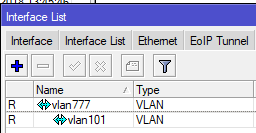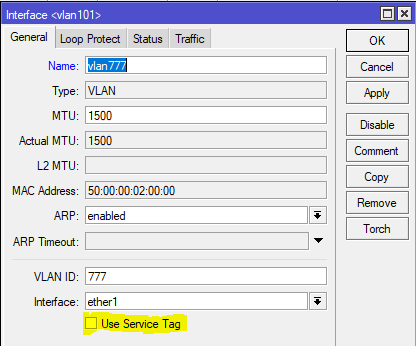Vagrant Libvirt Install openSUSE
Install Vagrant and the libvirt provider on OpenSUSE.Vagrant Libvirt Install openSUSE
I have recently started using openSUSE as my server platform of choice. This post will go over installing qemu-kvm and libvirt for use with Vagrant and the vagrant-libirt provider on openSUSE. For reference the following software will be used in this post. openSUSE - 15 Vagrant - 2.1.2 ...MikroTik ISP Design: Building an 802.1q trunk between sites using VPLS and S-tag
Use Case
ISPs that use MikroTik are always looking for new ways to deliver services to customers and expand their offerings. Delivering Layer 2 at scale for customers is a design challenge that comes up frequently.
While it’s easy enough to build a VLAN nested inside of another VLAN (see below), this requires you to build all of the VLANs a customer wants to use into the PE router or handoff switch.
However, if you have a client that needs a layer 2 service delivered to two or more points and wants to be able to treat it just like an 802.1q trunk and add VLANs in an ad-hoc way, then using the S-Tag feature in RouterOS along with VPLS transport is a great option.
What’s the S-tag do???
Clients will often ask me “what’s the S-Tag check box for?”
So a little background on this, there is a protocol for using outer and inner VLAN tags specified in IEEE 802.1ad that uses Service Tag (or S-Tag) to denote the outer VLAN tag used to transport Customer Tags (or C-Tags).
What makes the S-Tag/C-Tag a little bit different is that it actually changes the ethertype of the Frame.
| Continue reading |
|---|
MikroTik ISP Design: Building an 802.1q trunk between sites using VPLS and S-tag
Use Case
ISPs that use MikroTik are always looking for new ways to deliver services to customers and expand their offerings. Delivering Layer 2 at scale for customers is a design challenge that comes up frequently.
While it’s easy enough to build a VLAN nested inside of another VLAN (see below), this requires you to build all of the VLANs a customer wants to use into the PE router or handoff switch.
However, if you have a client that needs a layer 2 service delivered to two or more points and wants to be able to treat it just like an 802.1q trunk and add VLANs in an ad-hoc way, then using the S-Tag feature in RouterOS along with VPLS transport is a great option.
What’s the S-tag do???
Clients will often ask me “what’s the S-Tag check box for?”
So a little background on this, there is a protocol for using outer and inner VLAN tags specified in IEEE 802.1ad that uses Service Tag (or S-Tag) to denote the outer VLAN tag used to transport Customer Tags (or C-Tags).
What makes the S-Tag/C-Tag a little bit different is that it actually changes the ethertype of the Frame.
| Continue reading |
|---|
Juniper Announces New Acceleration Cards For SRX5000 Security Appliances
Juniper Networks has announced that it will soon begin shipping new SPC3 (Services Process Card) Advanced Security Acceleration cards for its SRX5000 line of security gateways, which includes the 5400, 5600, and 5800 appliances. These security appliances target large enterprises, service providers, and cloud providers. Customers can mix and match security features including firewalling, IPS, […]Iran State-Sponsored Hackers Pose Growing Threat, Accenture Says
 "It’s somebody’s day job to make sure they exploit you and remain a presence on your network,” said Josh Ray, global cyber defense lead for Accenture Security.
"It’s somebody’s day job to make sure they exploit you and remain a presence on your network,” said Josh Ray, global cyber defense lead for Accenture Security.
How many labels for VPN in MPLS
How many labels for VPN in MPLS ? For those who has good amount of knowledge in MPLS already may know the answer. Or if you have taken my CCDE course before, this question is basic for you. But understanding this fundamental piece of knowledge is key to understand MPLS Applications. MPLS […]
The post How many labels for VPN in MPLS appeared first on Cisco Network Design and Architecture | CCDE Bootcamp | orhanergun.net.
How many labels for VPN in MPLS
How many labels for VPN in MPLS ? For those who has good amount of knowledge in MPLS already may know the answer. Or if you have taken my CCDE course before, this question is basic for you. But understanding this fundamental piece of knowledge is key to understand MPLS Applications. MPLS …
Continue reading "How many labels for VPN in MPLS"
The post How many labels for VPN in MPLS appeared first on Cisco Network Design and Architecture | CCDE Bootcamp | orhanergun.net.
How many labels for VPN in MPLS
How many labels for VPN in MPLS ? For those who has good amount of knowledge in MPLS already may know the answer. Or if you have taken my CCDE course before, this question is basic for you. But understanding this fundamental piece of knowledge is key to understand MPLS Applications. MPLS …
Continue reading "How many labels for VPN in MPLS"
The post How many labels for VPN in MPLS appeared first on Cisco Network Design and Architecture | CCDE Bootcamp | orhanergun.net.
SDN, NFV, 5G Part of AT&T’s 2018 Capex Splurge
 “But once you get there those investments you are making to achieve that goal ebb out. They either come down or effectively stabilize,” said CFO John Stephens.
“But once you get there those investments you are making to achieve that goal ebb out. They either come down or effectively stabilize,” said CFO John Stephens.
VMware and Mist Collaborate for Wireless LAN, WAN Visibility and Troubleshooting
 The joint offering boasts interoperability between Mist’s Learning Wireless LAN and VMware VeloCloud-based NSX SD-WAN to bring AI and open programmability to WLAN and WAN.
The joint offering boasts interoperability between Mist’s Learning Wireless LAN and VMware VeloCloud-based NSX SD-WAN to bring AI and open programmability to WLAN and WAN.
Cisco Is Ready To Upgrade a Million Routers With SD-WAN Software
 The Viptela software can run on all Cisco ISR and ASR routers, as well as ENCS 5000 routers, that are four years old or younger.
The Viptela software can run on all Cisco ISR and ASR routers, as well as ENCS 5000 routers, that are four years old or younger.
History of Networking: Vint Cerf
In this recording of the History of Networking, Donald Sharp, Jordan Martin, and I sit with Vint Cert to discuss the origins of the Internet, and it’s commercialization.
IPv6 Buzz 005: IPv6 Goes To College
In the latest IPv6 Buzz podcast, Scott and Tom discuss the state of IPv6 in universities and higher education. Additional topics include: * How universities and higher education can benefit from IPv6 adoption * How security differs (and doesn’t) in higher education environments and how that might impact IPv6 deployment * Some IPv6 address planning […]
The post IPv6 Buzz 005: IPv6 Goes To College appeared first on Packet Pushers.



